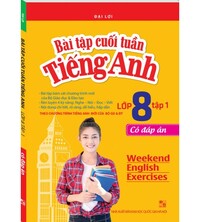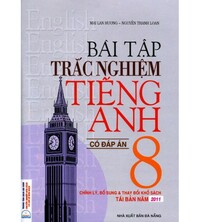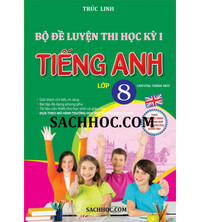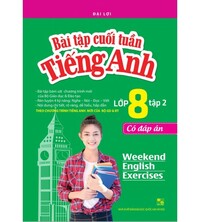Tiếng Anh 8 Unit 4 Reading: The future of food
THINK! What does “a superfood” mean? Can you think of any superfoods? 1. Read the article. Which problems does the text mention? 2. Read and listen to the article again and answer the questions. 3. VOCABULARY PLUS - Use a dictionary to check the meaning of the words in blue in the text. 4. USE IT! Work in pairs. How worried are you about world hunger? Is it a good idea to eat insects? Why / Why not?
Think!
THINK! What does “a superfood” mean? Can you think of any superfoods?
(“Một siêu thực phẩm” nghĩa là gì? Bạn có thể nghĩ ra siêu thực phẩm nào không?)
Lời giải chi tiết:
A superfood means a nutrient-rich food considered to be especially beneficial for health and well-being. Nuts (hazelnuts, walnuts, almonds, pecans…), fish and berries are examples of superfoods.
(Một siêu thực phẩm có nghĩa là một loại thực phẩm giàu chất dinh dưỡng được coi là đặc biệt có lợi cho sức khỏe và tinh thần. Các loại hạt (quả phỉ, óc chó, hạnh nhân, hồ đào…), cá và quả mọng là những ví dụ về siêu thực phẩm.)
Bài 1
1. Read the article. Which problems does the text mention?
(Đọc bài báo. Văn bản đề cập đến những vấn đề nào?)
pollution (ô nhiễm)
resources (nguồn tài nguyên)
farming (nuôi trồng)
crime (tội phạm)
The food of the future
INSECTS - The superfood of the future
There are a lot of hungry people in the world, so how do we deal with it? In the next thirty years, we'll need to provide enough protein for billions more mouths, and with all these extra people there will be even less space for farming. One solution is for us to eat insects. They are a great source of protein and they don't need as much space or water as farm animals.
So why don't we eat insects regularly? The fact is that many people in Asia, Africa and South America already do. The problem is that Europeans and North Americans don't want to. Some governments are now trying to convince them why it is a good idea. The Nordic Food Lab in Copenhagen, for example, developed the 'Insect Deliciousness' project. Its chefs have been to five continents to discover an incredible world of insect flavour. In Australia, they tasted honey ants. They ate fried caterpillars in Tanzania, and in Mexico, they enjoyed desert-ant eggs. Will they and other similar organisations persuade Europeans and Americans to take a bite from a caterpillar or an ant? What's your view? How many people will eat insects in the future? How much food made with insects will you eat?
Phương pháp giải:
Tạm dịch:
Thực phẩm của tương lai
CÔN TRÙNG – Siêu thực phẩm của tương lai
Có rất nhiều người đói trên thế giới, vậy làm thế nào để chúng ta đối phó với nó? Trong 30 năm tới, chúng ta sẽ cần cung cấp đủ protein cho hàng tỷ miệng ăn nữa, và với lượng người tăng thêm này, thậm chí sẽ có ít không gian hơn để canh tác. Một giải pháp cho chúng ta là ăn côn trùng. Chúng là một nguồn protein tuyệt vời và chúng không cần nhiều không gian hoặc nước như động vật trang trại.
Vậy tại sao chúng ta không ăn côn trùng thường xuyên? Thực tế là nhiều người ở Châu Á, Châu Phi và Nam Mỹ đã làm như vậy. Vấn đề là người châu Âu và Bắc Mỹ không muốn. Một số Chính phủ hiện đang cố gắng thuyết phục họ tại sao đó là một ý tưởng hay. Ví dụ, Phòng thí nghiệm Thực phẩm Bắc Âu ở Copenhagen đã phát triển dự án 'Món ngon côn trùng'. Các đầu bếp của nó đã đến năm châu lục để khám phá một thế giới hương vị côn trùng lạ thường. Ở Úc, họ đã nếm mật ong. Họ ăn sâu bướm chiên ở Tanzania, và ở Mexico, họ thưởng thức trứng kiến sa mạc. Liệu họ và các tổ chức tương tự khác có thuyết phục được người châu Âu và người Mỹ cắn một con sâu bướm hay một con kiến? Quan điểm của bạn là gì? Có bao nhiêu người sẽ ăn côn trùng trong tương lai? Bạn sẽ ăn bao nhiêu thức ăn làm từ côn trùng?
Lời giải chi tiết:
The problems that the text mentions are resources and farming.
(Vấn đề mà văn bản đề cập là nguồn tài nguyên và nuôi trồng.)
Bài 2
2. Read and listen to the article again and answer the questions.
(Đọc và nghe lại bài viết và trả lời câu hỏi.)
1. What problem will we have in the next thirty years?
(Chúng ta sẽ gặp vấn đề gì trong ba mươi năm tới?)
2. Why are insects the solution?
(Tại sao côn trùng là giải pháp?)
3. What does the word they in bold refer to?
(Từ “they” in đậm đề cập đến cái gì?)
4. In what parts of the world do people eat insects?
(Ở những nơi nào trên thế giới người ta ăn côn trùng?)
Lời giải chi tiết:
1. We’ll need to provide enough protein for billions more mouths, and with all these extra people there will be even less space for farming.
(Trong 30 năm tới, chúng ta sẽ cần cung cấp đủ protein cho hàng tỷ miệng ăn nữa, và với lượng người tăng thêm này, thậm chí sẽ có ít không gian hơn để canh tác.)
2. Because they are a great source of protein and they don't need as much space or water as farm animals.
(Bởi vì chúng là một nguồn protein tuyệt vời và chúng không cần nhiều không gian hoặc nước như động vật trang trại.)
3. “They” refers to the chefs of The Nordic Food Lab in Copenhagen.
(“They” ám chỉ các đầu bếp của Phòng thí nghiệm Thực phẩm Bắc Âu ở Copenhagen.)
4. In Asia, Africa and South America, many people eat insects.
(Ở Châu Á, Châu Phi và Nam Mỹ, nhiều người ăn côn trùng.)
Bài 3
3. VOCABULARY PLUS - Use a dictionary to check the meaning of the words in blue in the text.
(Sử dụng từ điển để kiểm tra nghĩa của các từ tô màu xanh trong văn bản.)
Lời giải chi tiết:
- deal with (phr.v): đối phó, đối mặt với
- solution (n): giải pháp
- convince (v): thuyết phục
- persuade (v): thuyết phục
- view (n): quan điểm
Bài 4
4. USE IT! Work in pairs. How worried are you about world hunger? Is it a good idea to eat insects? Why / Why not?
(Làm việc theo cặp. Bạn lo lắng thế nào về nạn đói thế giới? Có phải là một ý tưởng tốt để ăn côn trùng? Tại sao tại sao không?)
A: I'm not too worried about world hunger because there are many kinds of food we can eat.
(Tôi không quá lo lắng về nạn đói trên thế giới vì có nhiều loại thực phẩm chúng ta có thể ăn.)
B: I agree, but I think it's important that we start eating different things.
(Tôi đồng ý, nhưng tôi nghĩ điều quan trọng là chúng ta bắt đầu ăn những thứ khác nhau.)
Lời giải chi tiết:
A: I'm quite worried about world hunger because the reality for millions upon millions of people around the world is that they are undernourished or malnourished because they simply do not have any (or enough) food to eat.
(Tôi khá lo lắng về nạn đói trên thế giới vì thực tế đối với hàng triệu triệu người trên thế giới là họ bị thiếu dinh dưỡng hoặc suy dinh dưỡng vì đơn giản là họ không có (hoặc không đủ) thức ăn để ăn.)
B: I don’t think so, there are many food sources in the world for us.
(Tôi không đồng ý, tôi nghĩ trên thế giới có rất nhiều nguồn thức ăn cho chúng ta.)
A: Is it a good idea to eat insects?
(Ăn côn trùng có phải là ý tưởng tốt không?)
B: Yes, it is. Because insects can provide nutrition, with high protein, fat and mineral contents.
(Có chứ. Vì côn trùng có thể cung cấp dinh dưỡng, với hàm lượng chất đạm, chất béo và chất khoáng cao.)
Search google: "từ khóa + timdapan.com" Ví dụ: "Tiếng Anh 8 Unit 4 Reading: The future of food timdapan.com"







